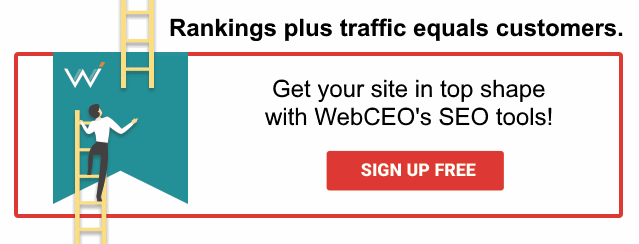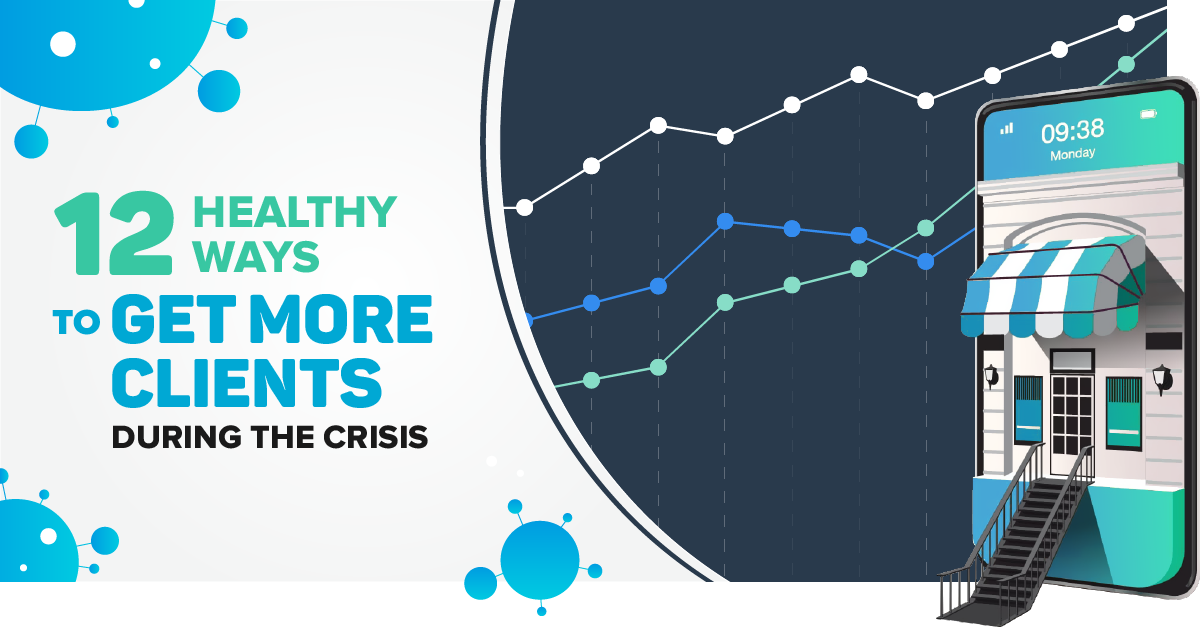
There’s no end in sight for this quarantine, so money has become an even bigger concern for everyone than it was before. Ecommerce may be booming worldwide, but companies are still losing money left, right and center. We all want to minimize our losses – and preferably, to come out richer than before when this crisis ends. The immediate goal is to get more customers for your business, but how?
Times like these are when you appreciate having over 7 billion people on Earth – more than enough to try out everything and find what works best. Let’s dive in.
1. Move from brick-and-mortar to online space
Working from home is an introvert’s paradise. Do you agree?
If you used to work from home before you got your own brick-and-mortar spot, welcome back to your humble roots. If not, this may be a shocking change for you. Particularly there is a problem shared by many a small business these days: running out of stock and having to explain it to customers.
There aren’t many ways around it other than by stocking up before it’s too late. When everyone shops online, reserves tend to go empty faster than you can say “coronavirus”.
Obviously, you will have an easier time if you are selling services rather than goods. For example, psychologists, lawyers and the like can still consult their clients online without any problem. Likewise, yoga and dance instructors can record their lessons and upload them on their YouTube channels. And Skype is now your friend, too.
2. Run an SEO audit
SEO may not be able to cure COVID-19, but it can definitely protect your business from its effects. Rankings and traffic can be converted to money, so they matter now more than ever before. Spend some time to bring your site to top condition through these steps:
- Optimize your content to satisfy user search intent
- Track how you rank for your keywords in search engines
- Find and fix technical errors on your site
- Find and remove low-quality backlinks
- Check if your site is mobile-friendly
- Make your internal linking structure more efficient
It sounds like a lot of work, but there is a fast way to check everything at once. If you already have a project in WebCEO and it has data (such as your keywords, competing sites and social media pages you are tracking), then you can create a consolidated report. Click on PDF Reports in the side navigation and click on the Add Report button.
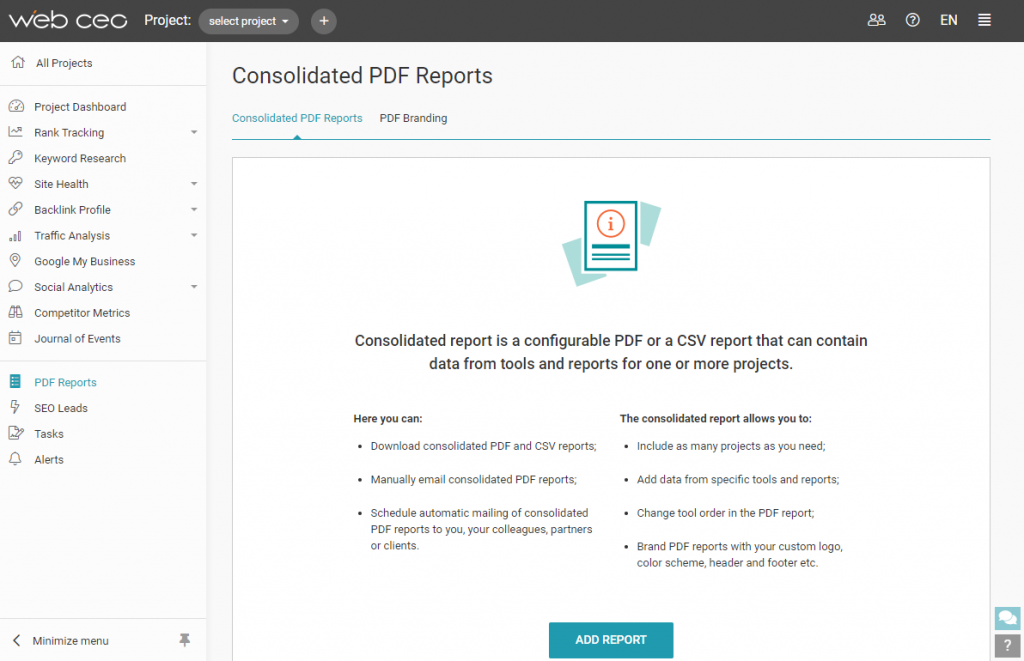
Choose your project in the Projects tab, then go to Report contents and check all the boxes that are relevant to you. (If you have doubts, you can check all the boxes, but then you’ll risk scrolling through dozens of report pages for the bits of information you actually need.)
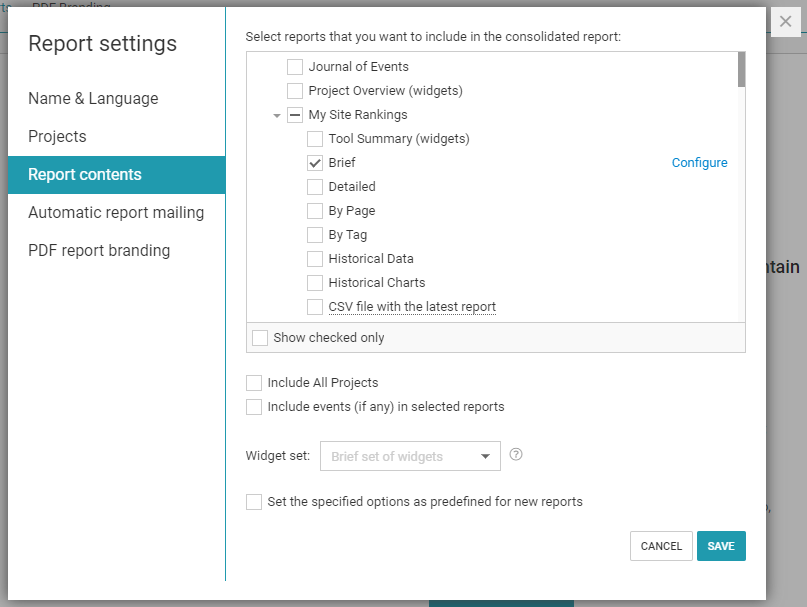
Click on Rescan associated tools to prepare the most recent data for your report. And lastly, click on Download PDF (hidden under the collapsible menu on the picture below) to generate the report in a new tab.
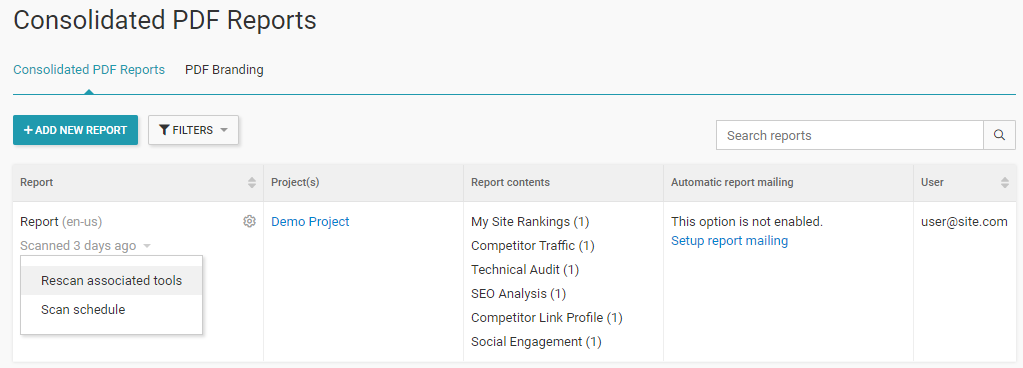
3. Work on improving your CTRs
High rankings are inseparable from high click-through rates. If you lose in one, you lose in the other. Good news is, tweaking your CTRs is much easier than optimizing your site.
Everywhere you have a presence, you want users to give you clicks too:
- Google search
- Social media
- Business directories
- Review directories
- Your own site
Usually, improving texts and images to appeal to users is enough to make something more clickable. But before you do, find out as much as you can about the click-through rates you have at the moment.
For Google search snippets, look at the Performance report in Google Search Console. Check the box in Average CTRs to display them in the graph and the table under it. You can view how many clicks you get for each website page or search query that causes you to appear in Google.
Social networks are a bit trickier, but they still have more than enough data to help you understand what’s going on. For example, Facebook has Insights for business pages where it displays things like post reach and actions on a page, and LinkedIn has Analytics and Activity. Twitter, too, has its Analytics, but on a separate subdomain.
And to check the user behavior on your site, use a heatmap generator like CrazyEgg.

4. Optimize for local SEO
Brick and mortar businesses have all but shut down during the crisis. The only places still open are the most essential ones like hospitals and grocery stores. But if you have closed and are not seeing customers face to face anymore, that’s no reason to give up on local search optimization. Sooner or later, the crisis will end, and you want your site and its positioning to be in shape when that happens.
If you are operating from home and still doing business, keep collecting positive reviews as usual – and the more, the better. Make sure your service and delivery are top-notch even if it’s barely profitable under the circumstances: if people remember you as that company that was really helpful during the quarantine, you will earn a major reputation boost.
Now, what if you are one of those essential organizations who don’t have the option to close their doors? Then that’s all the more reason to make yourself easy to find. For this, the most important thing is having a Google My Business listing.
If you have a listing in Google My Business, you can:
- Put your business on Google Maps.
- Track your customer reviews. You can see and reply to them in WebCEO’s Reviews report if you connect your WebCEO project to your Google My Business listing.
- Track customer activity like site visits and phone calls. You can do it in WebCEO’s Location Insights report.
To give yourself more of an edge, you can also:
- Sign up on business directories;
- Use location-based keywords on your site;
- Build backlinks to your site from local resources;
- Use structured data to add your business information to your Google search snippets.
5. Reassess your costs
Messing up and causing unnecessary losses is way easier than it should be. And in times like this, it tends to be outright ridiculous. On the other hand, this crisis is a nice excuse to be a little greedy and start spending less than before. Your profits will likely drop, but it’s better than not paying your employees or, in the worst-case scenario, going bankrupt. In other words, switch temporarily to the “low risk, low reward” mode.
What can you do to protect your budget? For example, you can spend less on paid ads and double down on free promotion strategies. Social media is promotion-friendly even if you don’t use ads, and there are also dozens of business directories where you can create listings.
Another good idea is to recycle your old content wherever possible. Outsourcing new content may be a luxury at the moment, while creating it yourself from scratch still takes time and resources.
You can also try to play long-term and spoil your customers with big discounts. It’s a good way to lure in some fresh blood and get more clients for your business, too.
6. Improve your UX for new users
Since the majority of the stores are closed, people’s number one option for shopping is the Internet now. You can expect an influx of new users who aren’t as familiar with online shopping as your regulars. Do everything to make sure they don’t bounce off in confusion, but instead join the ranks of your loyal customers. That means making your site easy to use for the less experienced newcomers.
So, how to get more sales when you are presented with this rich opportunity? Some of the easiest tips include:
- Easy-to-use, intuitive navigation
- All important information in the open
- FAQ page
- Your contact data and support
Here’s something on the more ambitious side: if you run an online store, it’s a great idea to create rotatable 3D models of your products to be displayed on your pages. Alternatively, (and it’s also easier), you can just create videos where you show your products from all angles.
Your regular users will appreciate the change in UX for the better, as well.
7. Be quick at converting new users
Following up on helping the newcomers adapt, you want to act quickly when they come to your site. New users may or may not figure out the necessary steps on their own. Help them out by extending a hand yourself first.
- Make your chats open automatically;
- Implement callback widgets;
- Track user activity, send them emails and phone messages (or even call them);
- Use retargeting to lure them back.
8. Hang out in social media
It must be good to be a Facebook or Instagram employee now. Social media is operating the same as ever, just like its users who have pages to visit and update. There’s some stability for social media users during these trying times. It’s also a nice chance to introduce someone new to your brand: people all over the world have more free time, and free time is a friend of social media.
Things you can do on your own pages:
- Run contests
- Create quizzes
- Offer free samples of your products
- Talk about fun things to do during the lockdown (like dressing up your house pet)
- Post content about doing activities related to your business at home (like workout routines)
Don’t forget to engage with other people’s pages, too, such as those of your biggest customers.
If you play your cards right, social media may prove extremely helpful at finding new clients – and strengthening your bond with the ones you already have.
9. Offer educational content
Have you heard that the Ivy League schools have offered 450 courses for free? And they aren’t the only ones. Various companies are doing the same for their target audiences.
People want to spend their free time productively – for example, by learning something new. And not just hobbies, but skills and knowledge that make actual money. If you are currently learning something yourself, hats off to you! But how about you reverse the process and teach your audience anything good, yourself?
Consider creating online lessons – preferably in a video format, because videos are all the rage at the moment. You can greatly increase the numbers of your clients by luring new users in with some freebies. And frequent video updates can easily turn them into your new regulars.
10. Make your customer service excellent
You may suddenly find that your customers need you way more often than usual. If it’s due to an influx of new users, that’s certainly a good sign. But it can happen even without a fresh wave of customers. Everybody wants faster service now because the only alternative is waiting on a line outside – not a very fun pastime.
Besides, they might need your help as soon as possible. Pandemics aren’t the only cause of emergencies.
So what can you do?
- Make sure your site loads quickly. Test your loading speed with WebCEO’s Page Speed tool.
- Set up live chat on your site. Be quick to reply to your users.
- Set up a chatbot for the times you aren’t around.
- Encourage customer feedback.
- Have an FAQ page.
11. Use CRM software and other useful tools
If you are among the lucky ones with more free time on their hands, now is a good chance to upgrade your website and your entire marketing campaign. Take a pen and a notebook (or just open Notepad), open your favorite search engine and answer the following questions.
- What are some tasks and aspects of your working process that could be made easier (or even fully automated) by using tools and software?
- What other tasks and aspects could be added to improve your campaign’s results? What tools do they require?
- What tools do you currently use?
- What are some of the better alternatives?
For instance, all things SEO (like monitoring your rankings and finding site errors) can be done with WebCEO. If you need help dealing with customers, that’s where customer relationship management (CRM) tools come in. TrustRadius has a good list of such tools with detailed explanations about what each of them does, along with user reviews. You will definitely find something that suits you.
12. Send positive vibes
Above all else, stay positive!
We are all starved for good news and can’t wait for mankind to triumph over the virus. Be optimistic and show it in everything you do on your site – meaning, don’t attempt to profit off people’s fears. Instead, do the opposite and reaffirm your visitors that we are all going to make it. Then we will brag to future generations about having lived through an event from the history books.
Here’s something you can do right now: reach out to your customers and let them know you’ve got their backs. If you have implemented any new features on your site or you have created special offers, share the news with them. The path to a better tomorrow where you attract more customers to your business starts as early as today.
High spirits, high traffic and high rankings – that’s the recipe for success online. How about you start by checking your rankings?
